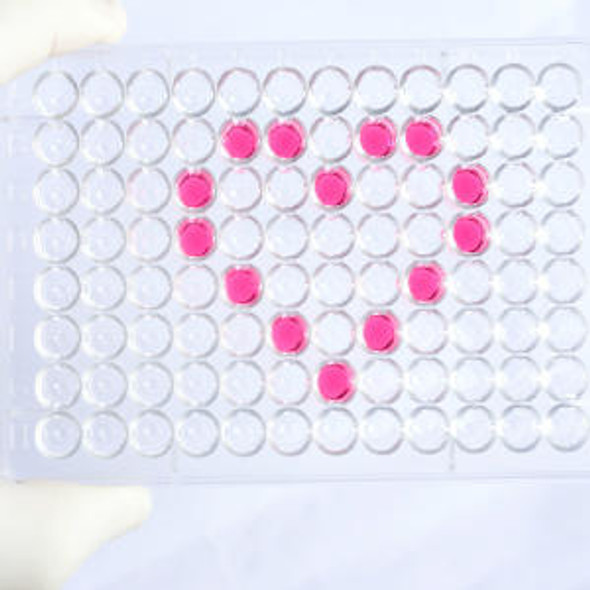Human Immunology ELISA Kits 9
Human DNA-(apurinic or apyrimidinic site) lyase (APEX1) ELISA Kit
- SKU:
- HUEB2050
- Product Type:
- ELISA Kit
- Size:
- 96 Assays
- Uniprot:
- P27695
- Range:
- 0.312-20 ng/mL
- ELISA Type:
- Sandwich
- Synonyms:
- APEX1, DNA-, apurinic or apyrimidinic site lyase
- Reactivity:
- Human
Description
| Product Name: | Human DNA-(apurinic or apyrimidinic site) lyase (APEX1) ELISA Kit |
| Product Code: | HUEB2050 |
| Alias: | DNA-(apurinic or apyrimidinic site) lyase, APEX nuclease, APEN, Apurinic-apyrimidinic endonuclease 1, AP endonuclease 1, APE-1, REF-1, Redox factor-1, APEX1, APE, APE1, APEX, APX, HAP1, REF1, 3.1.-.- |
| Uniprot: | P27695 |
| Reactivity: | Human |
| Range: | 0.312-20 ng/mL |
| Detection Method: | Sandwich |
| Size: | 96 Assay |
| Storage: | Please see kit components below for exact storage details |
| Note: | For research use only |
| UniProt Protein Function: | APE1: a multifunctional enzyme that plays a central role in the cellular response to oxidative stress including DNA repair and redox regulation of transcriptional factors. Binds DNA and RNA. Functions as an apurinic/apyrimidinic (AP) endodeoxyribonuclease in the DNA base excision repair (BER) pathway, a 3'-5' exoribonuclease for mismatched deoxyribonucleotides at the 3' termini of nicked or gapped DNA molecules, and a DNA 3' phosphodiesterase capable of removing lesions (such as phosphoglycolate) blocking the 3' side of DNA strand breaks. Is a loading factor for POLB onto non-incised AP sites in DNA, stimulates the 5'-terminal deoxyribose 5'- phosphate (dRp) excision activity of POLB, and involved in the DNA cleavage step of class switch recombination (CSR). Possesses reversible nuclear redox activity to regulate DNA binding affinity and transcriptional activity of transcriptional factors by controlling the redox status of their DNA-binding domain, such as the FOS/JUN AP-1 complex after exposure to IR. Binds to negative calcium response elements (nCaREs). Stimulates the YBX1-mediated MDR1 promoter activity, when acetylated at Lys-6 and Lys-7, leading to drug resistance. Is an endoribonuclease involved in the control of single-stranded RNA metabolism. Plays a role in regulating MYC mRNA turnover. In association with NMD1, plays a role in the rRNA quality control process during cell cycle progression. Interacts with SIRT1; the interaction is increased in the context of genotoxic stress. Interacts with HDAC1, HDAC2 and HDAC3; the interactions are not dependent on the APEX1 acetylation status. Up-regulated in presence of reactive oxygen species (ROS), like bleomycin, H2O2 and phenazine methosulfate. NPM1 stimulates endodeoxyribonuclease activity on double-stranded DNA with AP sites, but inhibits endoribonuclease activity on single-stranded RNA containing AP sites. Belongs to the DNA repair enzymes AP/ExoA family. |
| UniProt Protein Details: | Protein type:Endoplasmic reticulum; Deoxyribonuclease; Hydrolase; Transcription, coactivator/corepressor; Nuclear receptor co-regulator; Lyase; Nucleolus; EC 4.2.99.18; DNA-binding; DNA repair, damage Chromosomal Location of Human Ortholog: 14q11.2 Cellular Component: centrosome; cytoplasm; endoplasmic reticulum; mitochondrion; nuclear chromosome, telomeric region; nuclear speck; nucleolus; nucleoplasm; nucleus; perinuclear region of cytoplasm; ribosome Molecular Function:3'-5' exonuclease activity; chromatin DNA binding; damaged DNA binding; DNA binding; DNA-(apurinic or apyrimidinic site) lyase activity; double-stranded DNA specific 3'-5' exodeoxyribonuclease activity; double-stranded DNA specific exodeoxyribonuclease activity; double-stranded telomeric DNA binding; endodeoxyribonuclease activity; endonuclease activity; metal ion binding; oxidoreductase activity; phosphodiesterase I activity; phosphoric diester hydrolase activity; protein binding; ribonuclease H activity; site-specific endodeoxyribonuclease activity, specific for altered base; transcription coactivator activity; transcription corepressor activity; uracil DNA N-glycosylase activity Biological Process: base-excision repair; base-excision repair, base-free sugar-phosphate removal; DNA repair; positive regulation of DNA repair; regulation of mRNA stability; telomere maintenance |
| NCBI Summary: | Apurinic/apyrimidinic (AP) sites occur frequently in DNA molecules by spontaneous hydrolysis, by DNA damaging agents or by DNA glycosylases that remove specific abnormal bases. AP sites are pre-mutagenic lesions that can prevent normal DNA replication so the cell contains systems to identify and repair such sites. Class II AP endonucleases cleave the phosphodiester backbone 5' to the AP site. This gene encodes the major AP endonuclease in human cells. Splice variants have been found for this gene; all encode the same protein. [provided by RefSeq, Jul 2008] |
| UniProt Code: | P27695 |
| NCBI GenInfo Identifier: | 113984 |
| NCBI Gene ID: | 328 |
| NCBI Accession: | P27695.2 |
| UniProt Secondary Accession: | P27695,Q969L5, Q99775, |
| UniProt Related Accession: | P27695 |
| Molecular Weight: | 35,555 Da |
| NCBI Full Name: | DNA-(apurinic or apyrimidinic site) lyase |
| NCBI Synonym Full Names: | apurinic/apyrimidinic endodeoxyribonuclease 1 |
| NCBI Official Symbol: | APEX1 |
| NCBI Official Synonym Symbols: | APE; APX; APE1; APEN; APEX; HAP1; REF1 |
| NCBI Protein Information: | DNA-(apurinic or apyrimidinic site) lyase |
| UniProt Protein Name: | DNA-(apurinic or apyrimidinic site) lyase |
| UniProt Synonym Protein Names: | APEX nuclease; APEN |
| Protein Family: | DNA-(apurinic or apyrimidinic site) lyase |
| UniProt Gene Name: | APEX1 |
| UniProt Entry Name: | APEX1_HUMAN |
| Component | Quantity (96 Assays) | Storage |
| ELISA Microplate (Dismountable) | 8×12 strips | -20°C |
| Lyophilized Standard | 2 | -20°C |
| Sample Diluent | 20ml | -20°C |
| Assay Diluent A | 10mL | -20°C |
| Assay Diluent B | 10mL | -20°C |
| Detection Reagent A | 120µL | -20°C |
| Detection Reagent B | 120µL | -20°C |
| Wash Buffer | 30mL | 4°C |
| Substrate | 10mL | 4°C |
| Stop Solution | 10mL | 4°C |
| Plate Sealer | 5 | - |
Other materials and equipment required:
- Microplate reader with 450 nm wavelength filter
- Multichannel Pipette, Pipette, microcentrifuge tubes and disposable pipette tips
- Incubator
- Deionized or distilled water
- Absorbent paper
- Buffer resevoir
*Note: The below protocol is a sample protocol. Protocols are specific to each batch/lot. For the correct instructions please follow the protocol included in your kit.
Allow all reagents to reach room temperature (Please do not dissolve the reagents at 37°C directly). All the reagents should be mixed thoroughly by gently swirling before pipetting. Avoid foaming. Keep appropriate numbers of strips for 1 experiment and remove extra strips from microtiter plate. Removed strips should be resealed and stored at -20°C until the kits expiry date. Prepare all reagents, working standards and samples as directed in the previous sections. Please predict the concentration before assaying. If values for these are not within the range of the standard curve, users must determine the optimal sample dilutions for their experiments. We recommend running all samples in duplicate.
| Step | |
| 1. | Add Sample: Add 100µL of Standard, Blank, or Sample per well. The blank well is added with Sample diluent. Solutions are added to the bottom of micro ELISA plate well, avoid inside wall touching and foaming as possible. Mix it gently. Cover the plate with sealer we provided. Incubate for 120 minutes at 37°C. |
| 2. | Remove the liquid from each well, don't wash. Add 100µL of Detection Reagent A working solution to each well. Cover with the Plate sealer. Gently tap the plate to ensure thorough mixing. Incubate for 1 hour at 37°C. Note: if Detection Reagent A appears cloudy warm to room temperature until solution is uniform. |
| 3. | Aspirate each well and wash, repeating the process three times. Wash by filling each well with Wash Buffer (approximately 400µL) (a squirt bottle, multi-channel pipette,manifold dispenser or automated washer are needed). Complete removal of liquid at each step is essential. After the last wash, completely remove remaining Wash Buffer by aspirating or decanting. Invert the plate and pat it against thick clean absorbent paper. |
| 4. | Add 100µL of Detection Reagent B working solution to each well. Cover with the Plate sealer. Incubate for 60 minutes at 37°C. |
| 5. | Repeat the wash process for five times as conducted in step 3. |
| 6. | Add 90µL of Substrate Solution to each well. Cover with a new Plate sealer and incubate for 10-20 minutes at 37°C. Protect the plate from light. The reaction time can be shortened or extended according to the actual color change, but this should not exceed more than 30 minutes. When apparent gradient appears in standard wells, user should terminatethe reaction. |
| 7. | Add 50µL of Stop Solution to each well. If color change does not appear uniform, gently tap the plate to ensure thorough mixing. |
| 8. | Determine the optical density (OD value) of each well at once, using a micro-plate reader set to 450 nm. User should open the micro-plate reader in advance, preheat the instrument, and set the testing parameters. |
| 9. | After experiment, store all reagents according to the specified storage temperature respectively until their expiry. |
When carrying out an ELISA assay it is important to prepare your samples in order to achieve the best possible results. Below we have a list of procedures for the preparation of samples for different sample types.
| Sample Type | Protocol |
| Serum | If using serum separator tubes, allow samples to clot for 30 minutes at room temperature. Centrifuge for 10 minutes at 1,000x g. Collect the serum fraction and assay promptly or aliquot and store the samples at -80°C. Avoid multiple freeze-thaw cycles. If serum separator tubes are not being used, allow samples to clot overnight at 2-8°C. Centrifuge for 10 minutes at 1,000x g. Remove serum and assay promptly or aliquot and store the samples at -80°C. Avoid multiple freeze-thaw cycles. |
| Plasma | Collect plasma using EDTA or heparin as an anticoagulant. Centrifuge samples at 4°C for 15 mins at 1000 × g within 30 mins of collection. Collect the plasma fraction and assay promptly or aliquot and store the samples at -80°C. Avoid multiple freeze-thaw cycles. Note: Over haemolysed samples are not suitable for use with this kit. |
| Urine & Cerebrospinal Fluid | Collect the urine (mid-stream) in a sterile container, centrifuge for 20 mins at 2000-3000 rpm. Remove supernatant and assay immediately. If any precipitation is detected, repeat the centrifugation step. A similar protocol can be used for cerebrospinal fluid. |
| Cell culture supernatant | Collect the cell culture media by pipette, followed by centrifugation at 4°C for 20 mins at 1500 rpm. Collect the clear supernatant and assay immediately. |
| Cell lysates | Solubilize cells in lysis buffer and allow to sit on ice for 30 minutes. Centrifuge tubes at 14,000 x g for 5 minutes to remove insoluble material. Aliquot the supernatant into a new tube and discard the remaining whole cell extract. Quantify total protein concentration using a total protein assay. Assay immediately or aliquot and store at ≤ -20 °C. |
| Tissue homogenates | The preparation of tissue homogenates will vary depending upon tissue type. Rinse tissue with 1X PBS to remove excess blood & homogenize in 20ml of 1X PBS (including protease inhibitors) and store overnight at ≤ -20°C. Two freeze-thaw cycles are required to break the cell membranes. To further disrupt the cell membranes you can sonicate the samples. Centrifuge homogenates for 5 mins at 5000xg. Remove the supernatant and assay immediately or aliquot and store at -20°C or -80°C. |
| Tissue lysates | Rinse tissue with PBS, cut into 1-2 mm pieces, and homogenize with a tissue homogenizer in PBS. Add an equal volume of RIPA buffer containing protease inhibitors and lyse tissues at room temperature for 30 minutes with gentle agitation. Centrifuge to remove debris. Quantify total protein concentration using a total protein assay. Assay immediately or aliquot and store at ≤ -20 °C. |
| Breast Milk | Collect milk samples and centrifuge at 10,000 x g for 60 min at 4°C. Aliquot the supernatant and assay. For long term use, store samples at -80°C. Minimize freeze/thaw cycles. |






